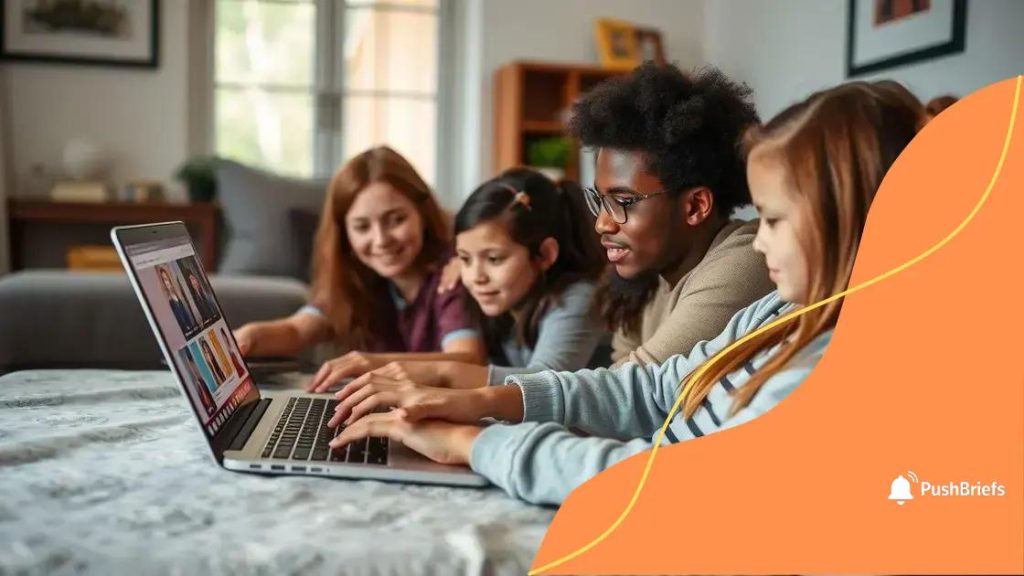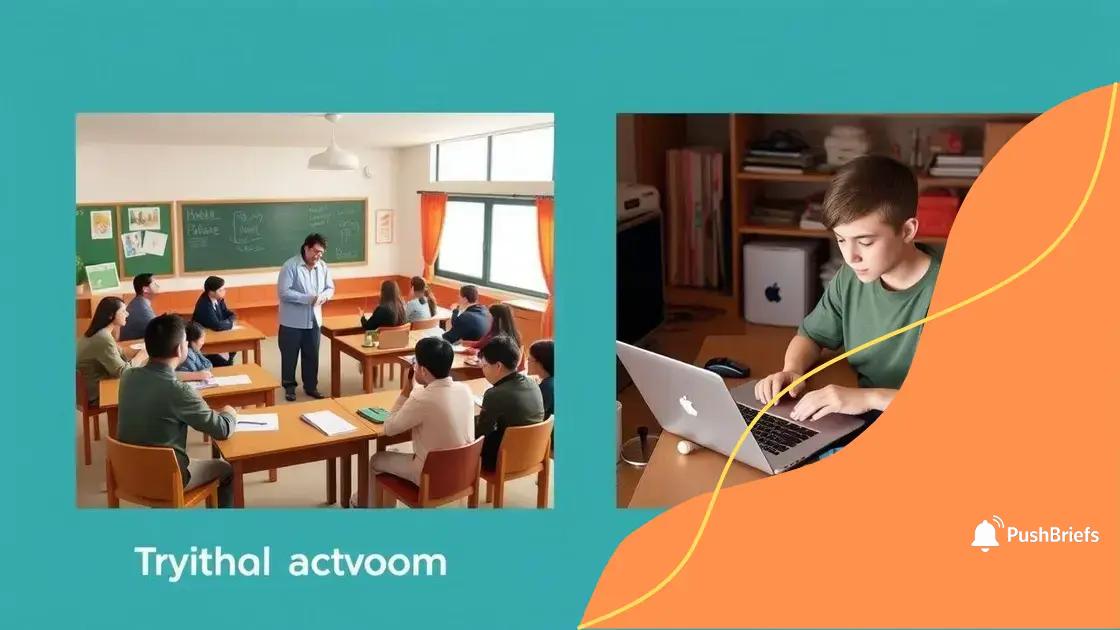The quality of online learning: can it improve outcomes?

The quality of online learning is enhanced by trends such as artificial intelligence personalization, microlearning, and social learning, which promote engagement and effectiveness for diverse student needs.
The quality of online learning is a subject of debate that many students and educators grapple with. Have you ever wondered how it stacks up against traditional schooling? Let’s dive into this intriguing discussion.
Understanding online learning quality metrics
Understanding the metrics involved in the quality of online learning is crucial for students and educators alike. These metrics help determine how effective the courses are and what areas might need improvement to enhance student outcomes.
Key Metrics to Consider
There are several important metrics to consider when evaluating online learning quality:
- Student Engagement: High levels of participation indicate that students are actively involved.
- Course Completion Rates: This metric shows the percentage of students who finish the course, providing insight into its effectiveness.
- Assessment Performance: Evaluating test scores can reveal how well students are grasping the material.
- Feedback and Satisfaction: Surveys can gauge how students feel about the course structure and content.
In addition to these metrics, it’s also essential to consider the flexibility of the learning environment. Students often perform better when they can learn at their own pace. As courses become more accessible online, students can balance their education with other responsibilities. This flexibility often leads to improved retention of information and increased satisfaction.
Another vital aspect of online learning quality is the use of technology. Quality platforms offer features such as interactive content, discussion forums, and live sessions. Using technology effectively can bridge the gap between isolation and community that sometimes occurs in online learning.
Comparative Analysis
When comparing online courses with traditional classroom settings, we see a mix of strengths and weaknesses. Online courses offer greater convenience, while face-to-face interactions can foster stronger relationships between students and instructors. However, with strategic planning and research on metrics, educators can create online learning experiences that rival traditional classrooms in quality.
As we move forward, every stakeholder in education must be aware of these quality metrics. This knowledge not only helps improve current offerings but also shapes the future of online learning.
Key factors influencing learning effectiveness
Several key factors influence the effectiveness of online learning, impacting how students absorb and understand material. These factors can vary, yet they are vital to building a successful online education framework.
Instructional Design
One of the most important aspects is instructional design. Effective courses often employ clear objectives, interactive elements, and consistent layouts. A well-structured course keeps learners engaged and focused. Using diverse materials such as videos, readings, and quizzes can also enhance understanding.
- Clear Learning Objectives: Students should know what they will learn from each module.
- Multimedia Usage: Incorporating different formats helps cater to various learning styles.
- Feedback Mechanisms: Incorporating quick feedback helps students gauge their understanding.
Next, the instructor’s presence plays a crucial role in online learning. Even in digital spaces, having an active and available instructor fosters better learning experiences. Instructors can connect with students through discussions, emails, and live sessions. This interaction creates a deeper connection and keeps students motivated.
Student Motivation
Moreover, student motivation is another key factor. When students are genuinely interested in learning, they tend to perform better. Setting personal goals or matching the content to their interests can help boost this motivation. Having a support system in place—such as study groups or mentorship—can amplify this positive energy.
The technological aspects are equally important. Reliable internet access and user-friendly platforms can either enhance or hinder the online learning experience. If students face technical difficulties, it may lead to frustration and disengagement. Therefore, ensuring that all participants have the tools they need is essential.
Furthermore, the online learning environment should feel inviting. A sense of community can significantly affect student engagement. Forums and discussion boards allow students to share ideas and collaborate, creating a cohesive learning environment.
Comparing traditional and online education

Comparing traditional education to online education reveals distinct advantages and challenges in each format. Understanding these differences helps students and parents make informed decisions about education.
Flexibility and Accessibility
One major advantage of online education is flexibility. Students can learn at their own pace, allowing them to balance their studies with work and personal commitments. This access to learning materials anytime and anywhere can be particularly beneficial for non-traditional students.
- Time Management: Students can create their own schedules that suit their lifestyles.
- Geographical Limitations: Online education breaks down location barriers, making it available to people regardless of their physical location.
- Diverse Course Offerings: Online platforms often offer a wider range of courses not available locally.
In contrast, traditional education provides a structured environment that can enhance discipline and motivation. Many students thrive in a classroom setting, where face-to-face interactions with teachers and peers encourage discussion and collaboration.
Social Interaction
A significant aspect of traditional education is the social interaction it offers. Students meet peers, build networks, and develop social skills through group activities and discussions. Relationships formed in a classroom setting can positively impact a student’s overall experience and personal growth.
Online education, while often isolating, has opportunities for social interaction through forums and virtual group projects. However, these digital interactions may lack the immediacy and depth of in-person connections, which can be crucial for some learners. Incorporating video conferences and real-time chats can help bridge this gap.
Learning Styles
When considering learning styles, traditional education typically caters to *visual*, *auditory*, and *kinesthetic* learners through diverse teaching methods. Teachers can directly assess student responses and adapt their teaching methods accordingly. In contrast, online education relies on self-directed learning, which may suit more independent learners but can pose challenges for those who require more guided instruction.
Both systems have their merits, and the best choice often depends on the learner’s unique needs and preferences. It’s important to evaluate what works best for each individual and their learning goals.
Real-world examples of effective online learning
Understanding real-world examples of effective online learning can provide valuable insights into best practices and innovative approaches. Many educational institutions and companies have adopted online learning strategies that yield impressive results.
Case Study: University of Phoenix
The University of Phoenix is a notable example, offering numerous online degree programs. Their focus on practical application and interactive learning experiences ensures high engagement levels among students. They provide essential resources like academic support and networking opportunities, enhancing the overall student experience.
- Diverse Course Offerings: A wide range of programs caters to various fields.
- Personalized Learning: Tools allow students to customize their study paths.
- Community Support: Active forums help students connect.
Another example is Coursera, which partners with leading universities and organizations to offer online courses. By leveraging high-quality video lectures and peer-reviewed assignments, Coursera has transformed online learning into an engaging experience. Users can learn at their own pace, which is crucial for adult learners balancing studies with other responsibilities.
Corporate Training: AT&T
In the corporate sector, AT&T has implemented online training programs for employees. Their courses emphasize skill development in a digital format, keeping employee engagement high. The company uses advanced analytics to tailor learning experiences based on individual employee needs.
This adaptation of online learning shows the importance of continuous training in a fast-evolving workplace. Engaging employees in their professional development results in higher job satisfaction and productivity. Businesses benefit by having a well-trained workforce who can adapt to new technologies and challenges.
Public Education: Khan Academy
Khan Academy is another excellent example, providing free online resources to students worldwide. With a blend of instructional videos and practice exercises, Khan Academy allows students to learn at their own pace. This method ensures that learners fully understand concepts before advancing, leading to improved academic outcomes.
The platform also offers tools for teachers, helping them track student progress and tailor instruction. This integration of technology in education showcases how online resources can support both learners and educators effectively.
Future trends in online education
Exploring future trends in online education offers insights into how learning is evolving. As technology advances, education adapts to meet new demands and opportunities for students and educators alike.
Increased Use of Artificial Intelligence
One of the most significant trends is the use of artificial intelligence (AI) in online education. AI can personalize learning experiences, providing tailored content and resources based on individual student needs. This technology analyzes data to create focused lesson plans and offers students instant feedback.
- Adaptive Learning: Systems that adjust content difficulty based on student performance.
- Intelligent Tutoring Systems: AI programs that guide students through complex topics.
- Data-Driven Insights: Utilizing analytics to improve curriculum design.
Another emerging trend is the growth of microlearning. This method breaks down information into smaller, manageable units, making learning easier and more engaging. Microlearning is particularly effective in online environments, allowing students to absorb content quickly and effectively.
Increased Emphasis on Social Learning
Social learning platforms are also gaining traction. These platforms promote collaboration among peers, enabling students to share ideas and resources. Learning from one another fosters a sense of community, which is often missing in traditional online formats. Tools like discussion boards and group projects help enhance this experience.
Also, the integration of virtual reality (VR) and augmented reality (AR) into education presents exciting possibilities. These technologies can create immersive learning environments, allowing students to explore complex concepts through interactive simulations and experiences. This engagement can lead to better retention of information and a deeper understanding of subjects.
Focus on Lifelong Learning
The future of education is shifting towards a model of lifelong learning. As job markets evolve and new skills are in demand, online education will play a significant role in helping individuals continuously update their knowledge and skills. Courses tailored to specific industries or professions will become increasingly popular, allowing learners to stay competitive.
Online platforms are already adapting to this trend by offering flexible, short-term courses that can quickly meet the changing needs of the workforce. This ability to learn on the go is crucial for busy professionals balancing work, family, and education.
FAQ – Frequently Asked Questions about Future Trends in Online Education
What role does artificial intelligence play in online education?
Artificial intelligence personalizes learning experiences, providing tailored content and interactive support based on individual student needs.
How does microlearning benefit students?
Microlearning breaks content into smaller, manageable units, making it easier for students to absorb and retain information quickly.
What is social learning, and why is it important?
Social learning promotes collaboration among students, allowing them to share ideas and resources, which enhances their overall learning experience.
How is virtual reality used in education?
Virtual reality creates immersive learning experiences, allowing students to explore complex concepts through interactive simulations, greatly enhancing engagement.
